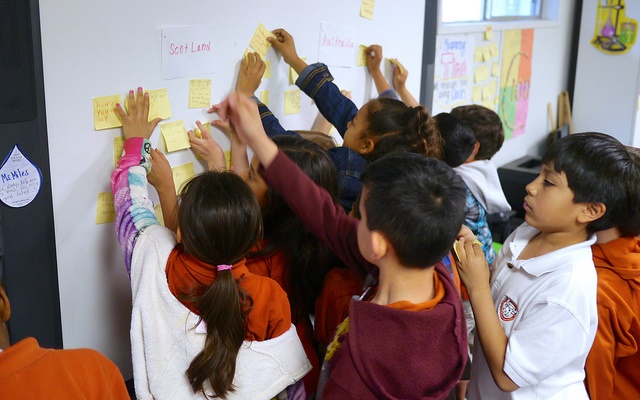 In a case of creative accounting, the nativist Federation for American Immigration Reform (FAIR) is blaming students for the fiscal woes of Texas. In a new report, FAIR lumps together students who are unauthorized immigrants with U.S.-born students who have unauthorized parents and claims that they are all costing Texas taxpayers astronomical sums in educational expenditures. However, the report (titled The Fiscal Burden of Illegal Immigration on Texans) mistakenly treats the education of these students as nothing more than a “cost” attributable to unauthorized immigration. In reality, the educational expenses targeted by FAIR are an investment in the future U.S. workforce and tax base; an investment that will pay off later as students become taxpaying workers.
In a case of creative accounting, the nativist Federation for American Immigration Reform (FAIR) is blaming students for the fiscal woes of Texas. In a new report, FAIR lumps together students who are unauthorized immigrants with U.S.-born students who have unauthorized parents and claims that they are all costing Texas taxpayers astronomical sums in educational expenditures. However, the report (titled The Fiscal Burden of Illegal Immigration on Texans) mistakenly treats the education of these students as nothing more than a “cost” attributable to unauthorized immigration. In reality, the educational expenses targeted by FAIR are an investment in the future U.S. workforce and tax base; an investment that will pay off later as students become taxpaying workers.
According to FAIR’s calculations, unauthorized immigrants are costing Texas taxpayers $12.1 billion dollars every year. However, $7.4 billion of this estimate, or 61%, consists of K-12 education for the children of unauthorized immigrants—of whom 71% are native-born U.S. citizens. FAIR justifies the decision to include U.S. citizens in its cost estimate by employing some warped logic:
We chose to include the expenditures on the U.S.-born children of illegal aliens because those costs would not have been incurred if the illegal aliens had been deterred from settling in Texas and/or deported or encouraged to return to their home countries. We assume that if the parent left they would take their children with them.
Translation: You can’t deport U.S. citizens, but maybe these U.S. citizens will just go away if and when we get rid of their parents. FAIR makes the same argument in the case of unauthorized students. According to FAIR, not only are these kids nothing more than an “expense,” but they can simply be made to pick up and leave the country, even if the United States is the only home they’ve ever known.
This argument is based on wishful thinking. It is an argument rooted in the fanciful “attrition through enforcement” strategy of immigration enforcement, in which life is made more and more difficult for unauthorized immigrants in the hope that they will “self-deport” and take their children with them. Yet evidence suggests this is unlikely to work in the case of unauthorized families with children who are firmly rooted in this country and who therefore have every reason to tough it out and stay.
The reality is that most of the students from unauthorized families are going to become American workers, consumers, taxpayers, and entrepreneurs when they grow up. As a result, it is in the U.S. economy’s best interest to ensure that these children are educated since that will increase their productivity, earning power, buying power, and tax payments later in life. It’s also worth noting that, in FAIR’s world view, the adult U.S.-born children of unauthorized immigrants are lumped in with the rest of the native-born population and their tax contributions are not credited back to the unauthorized families that raised them. They are only included as part of the unauthorized immigrant population when they are costly children who—like all children—“consume” educational and healthcare services before they are old enough to “repay” those expenses with tax payments.
In short, FAIR’s rather crude accounting methods reflect a very limited understanding of the economic and social complexities of immigration. FAIR imagines that Texas (and every other state) would be better off if immigrants had never arrived; that there would be more jobs and more services for native-born citizens. But that is not how the real world operates. Without immigrants there would be fewer jobs, fewer businesses, and less government revenue. Employment is not a zero-sum game in which foreign-born and native-born workers compete with each other for some fixed number of jobs. The U.S. economy depends on immigrants in myriad ways—just as it always has.
Photo Courtesy of Ewan McIntosh.
FILED UNDER: Children, enforcement, FAIR Methodology, featured, Nativists, Restrictionists, Rhetoric, Students, Texas


